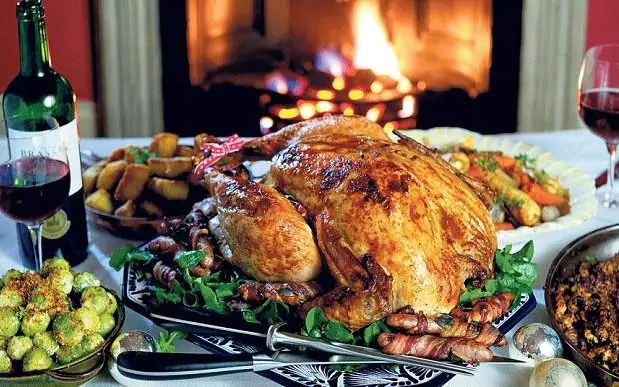It's the biggest meal of the year – even if your plans are not quite as you had expected – and one that you can't afford to get wrong, especially if you've got a table full of hungry relatives waiting to be fed.
You've got the turkey, but how exactly do you cook it and more importantly, how do you know it's cooked? As much as we look forward to this part of the traditional Christmas dinner, we forget that turkey is not something typically cooked throughout the rest of the year.
Here, we've pulled together a step-by-step guide on everything you need to know about your turkey, including what to look for when choosing it, how to prepare it properly for cooking, and recipes for any leftovers - because there are always leftovers and so many innovative ways to use up your remaining turkey.
Tips For How To Roast A Turkey
Preparation Tips For Your Turkey
Do remember to take the wishbone out before cooking as it makes the breast easier to carve. It's important to remember to not stuff the turkey in the main cavity from behind. Stuff it from the neck end to ensure the whole bird cooks properly.
Weigh the bird after stuffing to calculate the cooking time. For a quick roast bird, bake the stuffing separately but remember to secure all the stuffing in the turkey with a skewer.
Put a large glass of wine and some water in the roasting tin to make more juice for the gravy and give your turkey legs a jiggle, to see if the meat is tender.
Invest In A Meat Thermometer When Cooking Your Turkey
It’s the only way to ensure a perfectly roasted turkey. Thrust the thermometer into the thickest part of the thigh (don’t let the point touch the bone) to check if it has reached the right temperature.
Paul Kelly, of Kelly Bronze Turkeys, recommends taking the bird out of the oven when it hits 65C, but you may want to let the temperature rise to 70C first, especially if your bird is not free-range.
Let The Turkey Rest
It’s a crucial part of the cooking time, so never, ever, carve a turkey straight out of the oven. It needs at least half an hour, and up to an hour and a half, covered in foil and sitting on the side in the kitchen (valuable time in which to make the gravy and finish the vegetables). The turkey will continue to cook and the internal temperature will go on rising, by a good 10C.
Remove the turkey from the fridge an hour before cooking, to bring it to room temperature. Weigh it so you know how long it will take in the oven – or else you'll spend the whole of Boxing day and beyond with a dicky tummy.
Delve into the back end of the bird and find the wishbone. It will be the first piece of bone visible, forming an arch between the two breasts. Some people cook the turkey with the wishbone intact, but it is easier to carve the breast if you take it out before cooking (it also prevents any choking mishaps). Grab your knife and slide it along the edge of the bone, before tearing it out.
Take the giblets out if you haven't already (they're usually in a plastic bag) and start stuffing the turkey. Only stuff the turkey from the neck end. You don't want to stuff it from the main cavity (the backside of the turkey) as keeping that empty improves the air circulation in and around the bird, allowing it to cook faster and more evenly. If you do stuff from behind then the inside may not get hot enough to kill any bacteria present, which can result in food poisoning.
Go gently when stuffing under the skin – you don't want it to tear. Secure the stuffing with a skewer, lather the bird with slabs of butter (this will stop the meat from drying out), and pour a large glass of white wine and another of water into the bottom of the roasting tin. This will mix with the cooking juices and stop them from evaporating – important, because you want lots of juice for your gravy later.
Allow to rest for between 30 minutes to an hour so it is as tender as can be when carving.
When carving the turkey start on one side of the breast and cut down diagonally until you get to the centre, then repeat on the other side. Most people nowadays will just cut down the middle of the turkey and cut each breast off as a whole but this leaves you with just the carcass of the turkey at the end of the carving (if you spent that long cooking it you kind of want it to look as pretty as can be for as long as can be).
To take the turkey leg off, carve the meat down to the point when you can feel a joint in the middle. Put your thumb in the gap you have just made and pull away the meat, popping the joint out.
Turkey Cooking Times
Preheat the oven to 200C/220C fan/gas mark 6. Put the turkey in the oven and cook for 15 minutes then turn down the oven to 180C/160C fan/gas mark 4 and cook for a further:
- 3kg (6.6lb) – 1¾ hours
- 4kg (8.8lb) – 2 hours
- 5kg (11lb) – 2¼ hours
- 6kg (13.2lb) – 2½ hours
- 7-8kg (15.5lb – 17.7lb) – 3 hours
- 9-11kg (19.8lb – 24.2lb) – 3¼ hours
Please note that weights include stuffing and that cooking times are only approximate.
Tips On How To Choose A Turkey
As previously mentioned, a turkey is not a traditional meat featured at our weekly Sunday Roast dinners - so you'd be forgiven for not immediately knowing what type of turkey you want for your Christmas Dinner.
There are several types to choose from, with bronze, slate, KellyBronze, Bourbon Red, Norfolk Black being the usual suspects come Christmas time.
Bronze turkeys are traditionally larger, with fuller flavour, with a larger breast than a Norfolk Black turkey. Slate turkeys aren't as aesthetically pleasing - however are very popular among true turkey lovers for their taste.
A KellyBronze is a commercial brand of turkey, rather than a breed but remain popular due to the stock being kept at a minimum age and fed on a strict diet.
Bourbon Red turkeys originated in Kentucky and have a stronger, gamier flavour - as well as being smaller than other breeds. Finally, the classic Norfolk Black come from some of the first turkeys brought to the UK from America.
Leftovers
If you're a household which ends up with near to no leftovers post-Christmas dinner, we salute you. However, if, like the majority of us, there's always remaining food on the table, fear not - there's absolutely no need to waste any this Christmas.
What's key is that you strip the remaining meat from the bones of your bird after you've eaten and think ahead regarding meals. You can freeze turkey meat for up to two months - or you might find it's just the right amount to feed your family for the days to come after the big meal.
Use the meat in curries, pies and sandwiches, while the bones can be slow cooked and simmered to create a delicious meaty stock. Any leftover skin can be baked to create crispy turkey scratchings - which can be eaten solo as a snack or used to garnish salads.

